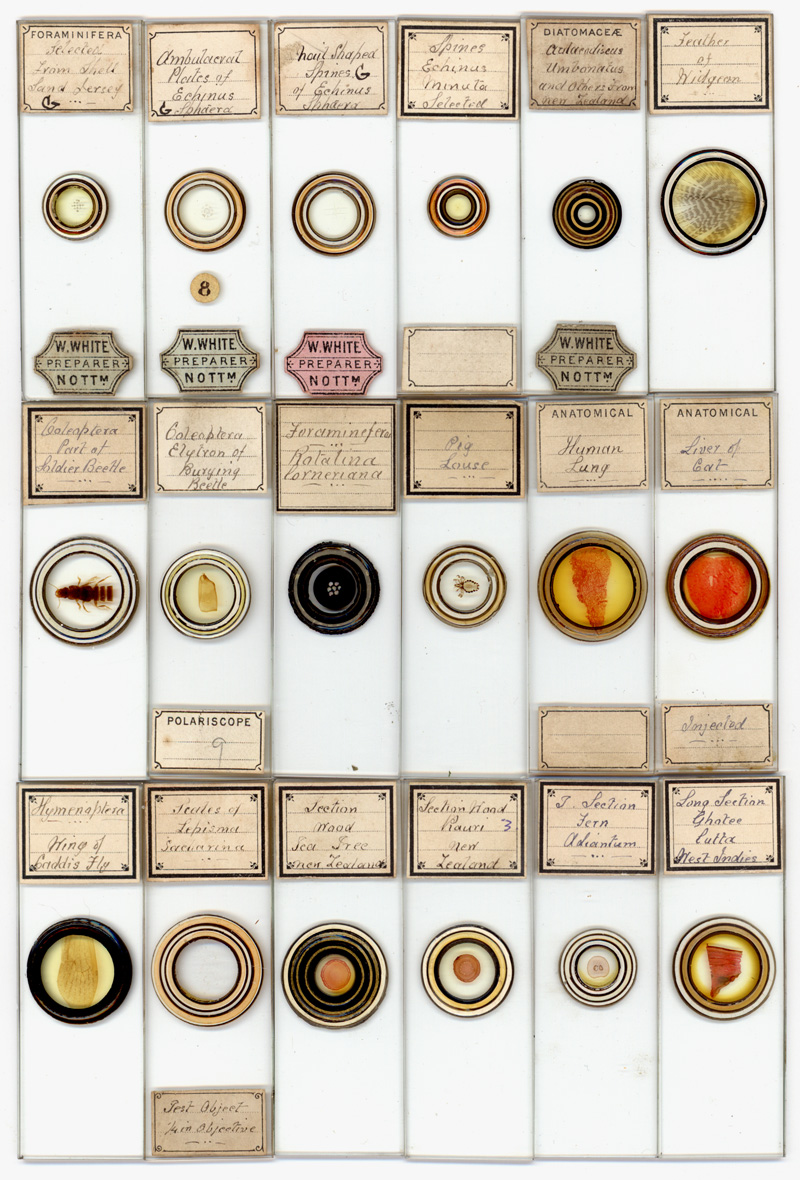
George Harris (“W. White”), microscope slide preparer, ca. 1835 - 1904
Brian Stevenson, Kentucky, USA
If one may judge from the number of his slides that show up for sale on the internet these days, W. White of Nottingham was a significant producer of microscope slides in late Victorian/Edwardian England. However, the vast majority of his slides seen today do not bear his name, so the maker is largely unrecognized. It is probable that many were sold without the maker’s name attached. Moreover, W. White used separate labels for the specimen name and the maker’s name, and it appears that many purchases removed the W. White label. For these reasons, it is not surprising that several prominent microscope slide experts have told me that they do recall having ever seen a W. White slide. Following is a description of W. White’s microscope slides, along with presentation of evidence that the man who made the slides labeled “W. White” was named George Harris.
W. White slides are readily recognized by a number of common features (Figures 1, 2 and 3). An upper label carries a handwritten description of the specimen. The handwriting is distinctive, and easily distinguished. Occasionally, a lower label is found, typeset with “W. WHITE PREPARER NOTTM”. Alternative lower labels, with an additional, handwritten description is sometimes seen. Most W. White slides I have examined do not have a lower label. Ringing is usually patterned with several concentric rings. Shades of yellow and orange were frequently used, separated with black and/or white rings. Of the 200+ W White slides I have seen, only 2 have plain black ringing. Two slides are known that lack a lower label, but have the initials “W W” written in the maker’s hand at a corner of the upper label.

Figure 1. Examples of microscope slides produced by “W. White.” The maker’s handwriting is distinctive. Ringing generally consists of 3 or more concentric rings, with a tendency to toward use of yellow and orange. He produced slides with a wide variety of specimen types, including diatoms, foraminifera, urchin spines, whole and partial insects, vegetation sections, and human and other anatomical preparations.
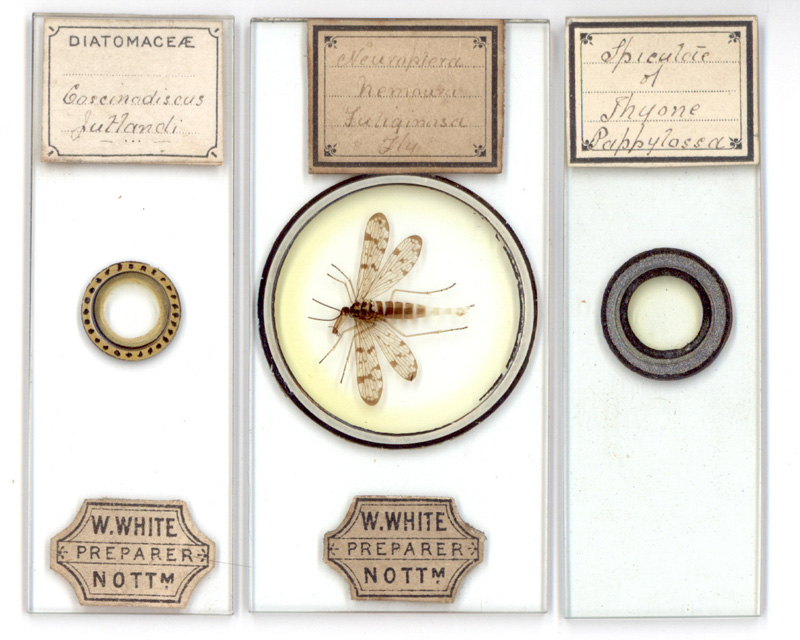
Figure 2. Three unusual slides by “W. White.” Left to right: Arranged diatoms with a dashed pattern added to the ringing; A 1 ½ x 3 inch slide of a Neamura fuliginasa (now Sialis fuliginosa, the alder fly); spiculae with metallic, glittery silver paint used for the ringing.
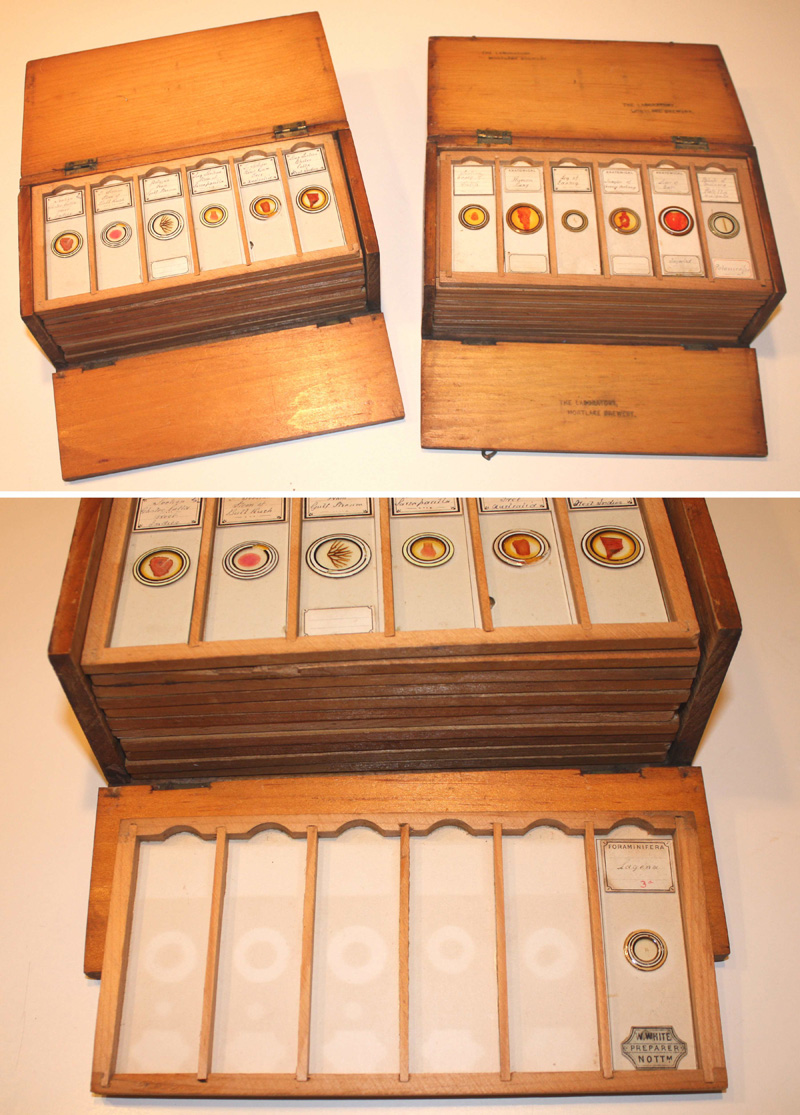
Figure 3. Two almost-complete 72-slide cabinets of slides by W. White. At the time of acquisition, one contained 68 slides, the other 69, all by W. White. It is highly likely that these were the original boxes supplied by the maker. One shelf of the left box was darkened, probably by prolonged exposure to the sun, leaving negative images of the contents burned into the paper. The images are identical to those of W. White slides that include the lower, identifying label (the slide shown on that tray was not included in the acquisition, and is being shown for comparison). None of the slides that came with either box contained lower labels, suggesting that a previous owner removed the W. White name labels. The box on the left was obtained from a lady whose father had bought it for her in Essex during the early 1960s. Both cabinets were acquired through eBay within 12 months of each other, suggesting that boxes of W. White slides are not especially rare.
The earliest records of W. White yet identified are two 1879 advertisements that appeared in Hardwicke’s Science-Gossip (Figure 4). He did not advertise in earlier issues of Science-Gossip, suggesting that he began Britain-wide distribution during 1879. The “exchange” nature of his advertisements further suggests that this early distribution was of limited scope. Noting that W. White advertised arranged diatoms for exchange in 1879, he appears to have developed reasonable skills of mounting individual diatoms by that time, not a simple feat. His known arrangements are well made, although nowhere as complex as those made by diatom specialists such as Möller, Thum or Gatrell. Exchange offers over the next several years indicate a diversity of specimen interests, consistent with the known range of specimen types mounted by W. White (Figure 1).
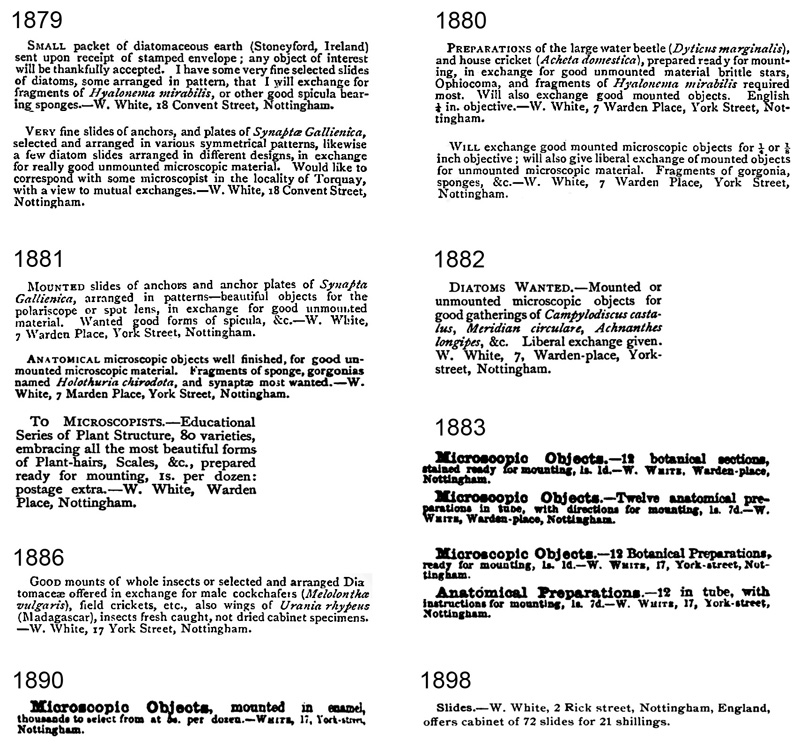
Figure 4. Advertisements from W. White. The two ads from 1879 issues of Hardwicke’s Science-Gossip are the earliest known from this mounter. He did not advertise in previous issues of this magazine.
The earliest known advertisements from W. White (1879) place him at 18 Convent Street, Nottingham. By the following year, he was advertising from 7 Warden Place, York Street. York Street is about 0.3 miles from Convent Street. Warden Place appears to have been a building, or a cul-de-sac off York Street. Part way through 1883, W. White’s postal address changed to 17 York Street. By 1898, W. White’s address had moved a short walk away to 2 Rick Street.
Learning more about W. White has been complicated. Very few people surnamed White, with the initial “W.”, were recorded on censuses as living in Nottingham during the late 1800s. Significantly, nobody with the name “White” lived at the advertised addresses of W. White. That strongly suggests that “W. White” was not the maker’s true name. The use of a pseudonym by a professional preparer was not uncommon. Consider that J.C. Tempére labeled his microscope slides “S. Louis”. In modern times, sellers and buyers on eBay often use pseudonyms to protect their identities. Possible reasons for “W. White” using that name are discussed below.
Censuses were taken every 10 years in Britain, beginning in 1841. The 1881 census shows that 17 York Street was occupied by a lacemaker named Thomas Ryan and his wife. At that time, W. White advertised from Warden Place. The Ryans no longer lived on York Street in 1891, and so can be removed from consideration as having been the maker of W. White slides.
In 1891, when W. White advertised from 17 York Street, the house was occupied by George and Mary Jane Harris. They were the only occupants of the building, as the Ryans had been in 1881, indicating that this was a single-family house. George was recorded as being a maker of electric instruments, and Mary Jane was a laceworker. George was listed as being “neither employer nor employed.” In other words, he did not work for anyone, nor did anyone work for him. In 1898-99, George Harris lived at 2 Rick Street, Nottingham.
Several magazine advertisements also connect George Harris and W. White. In 1887, W. White requested insect specimens in exchange for either mounted objects or electric apparatus (Figure 5). W. White later advertised to exchange a microscope and a cabinet of 144 microscope slides for copper wire (Figure 5). Conclusive evidence comes from a series of advertisements published in 1889. George Harris advertised from 17 York Street to sell a variety of items, including a “medical coil, with terminals for primary and secondary currents, draw-tube, regulator, bichromate battery, and handles, complete, quite new” a “powerful electro-motor, ¾ spark, induction coil, and lot of sundry apparatus for static electricity” and a “monocular microscope, four achromatic objectives, two eyepieces, stand, condenser, live-cage, forceps, &c. in a mahogany cabinet.” Shortly thereafter, ads appeared from W. White, also of 17 York Street, for the sale of a “medical coil, handles and bottle, bichromate battery, quite new”, a “powerful electro-motor, on mahogany stand, medical coil, with handles, regulator, and battery complete, also lot of electrical sundries”, and a “monocular microscope, with 4 objectives, condenser, &c., in mahogany cabinet” (Figure 5).
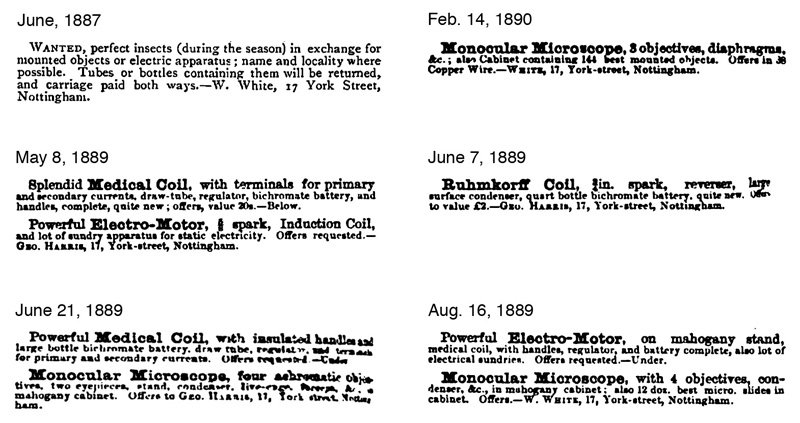
Figure 5. Advertisements connecting W. White with George Harris. In 1887 and 1890, W. White offered exchanges in return for electric apparatus and the sale of a microscope and slides in return for copper wire. During 1889, George Harris offered to sell electric apparatus and a microscope. Ads for the same equipment were also placed under the name W. White. Note that George Harris and W. White both advertised from 17 York Street.
The microscopes sold by W. White/George Harris were probably second-hand instruments. The monocular scope described in Figure 5 appeared in advertisements over several months, as did later a binocular microscope. As a self-described maker of electric instruments, the majority of the electric apparatus sold by Harris/W. White were probably made by him. His requests for copper wire support that conclusion. On occasion, he also offered unrelated objects for sale (Figure 6). These appear to have been second hand. The limited number of conjuring cabinets offered for sale suggests that they were not made by him (if made by Harris, he could have built more as required), while the description of the handsome little steam engine as “equal new” indicates that it was not actually new.
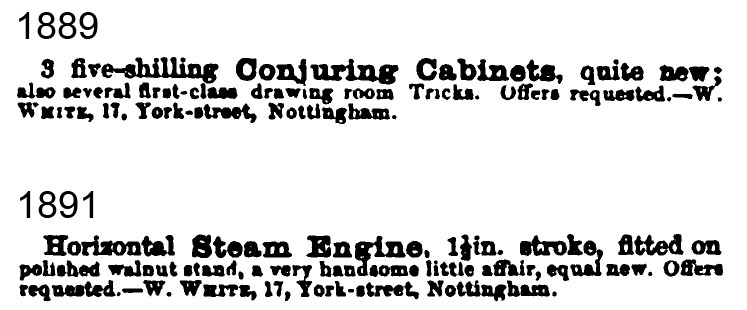
Figure 6. Other items offered for sale by W. White: conjuring cabinets, drawing room tricks and a steam engine.
The primary occupation of George Harris appears to have been electrical worker, as he always described himself as such to census takers. Wright’s 1894-95 Directory of Nottingham contained the listings, “Harris George, electrician, 17 York street” and “Electrical Engineers: Harris George, 17 York street”. Wright’s 1898-99 Directory of Nottingham listed “Rick st (Glasshouse st), An.: 2 George Harris, electrician”, “Harris, George, electrician, 2 Rick street”, and “Electricians: Harris, George, 2 Rick st, Glasham st”. Recall that both of these addresses were also addresses of W. White (Figure 4).
Harris’ occupation as an electrician leads to a suggestion as to why he advertised as “W. White”. The Electrical Trades' Directory and Handbook for 1890, 1895, 1899 listed “White, W., Electrician. 17, York-st, Nottingham.” Nobody in Nottingham named W. White was recorded as being anything like an electrician on either the 1871, 1881, 1891 or 1901 censuses. George Harris appears to have named his business “W. White”. Why, we will probably never know. He may have begun his trade working in a business signed with the name “W. White”, and, having become associated with that name by customers, he decided to keep it for a business name after he moved. Similarly, having opted for the name “W. White” for his microscopy business, Harris would have lost substantial business had he switched the name on slide labels to “G. Harris”. Alternatively, a group of houses on York Street were known as “White Rents”. Another possibility is that Harris was associated in some way with another part-time professional mounter of the era named Walter White. But Harris’ sale of items unrelated to microscopy while using the name “W. White” makes that possibility rather remote. Walter White’s microscope slides do not resemble in any way those of W. White.
According to what he reported to census takers, George Harris was born in Norwich, Norfolk around 1835 (only age was recorded on censuses, not birth year). Censuses also record that he had a son, Herbert, born ca. 1865 in Norwich. George’s wife Mary Jane was born ca. 1852 in Aslockton, Nottinghamshire. The age differences between Mary Jane and Herbert suggest that she was George’s second wife. Mary Jane signed George’s death record with an “X”, indicating that she was illiterate. Records for these people’s births, or George and Mary Jane’s marriage, have not been conclusively identified. Numerous people with these names were born or were married at the dates in question. The family is first identifiable in the 1881 census, when George was listed as a telegraphic engineer, Mary Jane as a seamworker, and 16 year-old Herbert as an embosser. In March of 1881, they lived at 1 Wood Court in Nottingham’s St. Mary district. I could not discover exactly where Wood Court was located. Warden Place was not identified in the 1881 census.
Altogether, a picture emerges of George Harris as a small-time maker of electrical apparatus. He also sold used electrical and other items. At some time prior to 1879, Harris developed an interest in microscopy, and began making and selling slides. Whether he was trained by someone, or self-taught is not known, but a high degree of skill is apparent. Harris’ insect specimens are well laid out. His arranged diatoms, spicules, etc. show high degrees of artistry and care. The multi-colored ringing patterns used by Harris suggest a love for his work, since plain black would have done the job just as well.
Harris’ microscope slide business continued until close to the turn of the 20th century. His electrical business lasted at least as long. He probably never achieved great financial success. The 1901 census recorded Harris as an unemployed 72 year-old, living with Mary Jane and two boarders at 11 Pritchard Terrace, Lotus St., still within St. Mary’s parish. George Harris died at the age of 74 on 11 January, 1904, from “senile dementia & senile decay” (probably Alzheimer’s disease). At the time of his death, Harris lived at the Nottingham Workhouse.
Comments
to the author will be welcomed.
Acknowledgements
I am indebted to Steve Gill for his invaluable assistance in this research, and to colleagues who provided images from their collections.
Resources
American Monthly Microscopical Journal (1898) Advertisement, Vol. 19, page 26.
Bracegirdle, Brian, 1998, Microscopical Mounts and Mounters, Quekett Microscopical Club, London.
Death record for George Harris, 11 January, 1904.
“The Electrician" Electrical Trades' Directory and Handbook for 1890, 1895, 1899, Listing for W. White, page 659.
English Mechanic and World of Science (1883) Advertisements, Vol. 36, pages 418 and 466
English Mechanic and World of Science (1883) Advertisements, Vol. 37, March issue pages v and 72, April issue page v.
English Mechanic and World of Science (1885) Advertisements, Vol. 41, March 13 issue page vi, June 12 issue page 334, August 21 issue page v, August 28 issue page vi.
English Mechanic and World of Science (1889) Advertisements, Vol. 49, pages 208, 314, 358 and 534.
English Mechanic and World of Science (1890) Advertisements, Vol. 50, pages 149, 270 and 516.
English Mechanic and World of Science (1891) Advertisements, Vol. 53, page 126.
English vital statistics, accessed through http://www.ancestry.co.uk
The Field Naturalist and Scientific Student (1882) Advertisement, No.1, page 67
Hardwicke’s Science-Gossip (1879) Exchange advertisements, Vol. 15, pages 144 and 168.
Hardwicke’s Science-Gossip (1880) Exchange advertisements, Vol. 16, pages 96, 192 and 240.
Hardwicke’s Science-Gossip (1881) Exchange advertisements, Vol. 17, pages 48, 96, and 284.
Hardwicke’s Science-Gossip (1882) Exchange advertisements, Vol. 18, pages 72 and 240.
Hardwicke’s Science-Gossip (1883) Exchange advertisements, Vol. 19, pages 24 and 96.
Hardwicke’s Science-Gossip (1884) Exchange advertisements, Vol. 20, pages 144 and 240.
Hardwicke’s Science-Gossip (1886) Exchange advertisements, Vol. 22, page 216.
Hardwicke’s Science-Gossip (1887) Exchange advertisements, Vol. 23, pages 48 and 144.
Northern Microscopist and Microscopical News (1881) Exchanges advertisements, Vol. 1, page 100.
Northern Microscopist and Microscopical News (1882) Exchanges advertisements, Vol. 2, page 324.
Wright’s Directory of Nottingham, 1894-95, Listings for George Harris, pages 216 and 358
Wright’s Directory of Nottingham, 1898-99, Listings for George Harris, pages 109, 222 and 365.
Microscopy UK Front
Page
Micscape
Magazine
Article
Library
Published in the December 2009 edition of Micscape Magazine.
Please report any Web problems or offer general comments to the Micscape Editor .
Micscape is the on-line monthly magazine of the Microscopy UK website at Microscopy-UK .
© Onview.net Ltd, Microscopy-UK, and all contributors 1995 onwards. All rights reserved. Main site is at www.microscopy-uk.org.uk with full mirror at www.microscopy-uk.net .